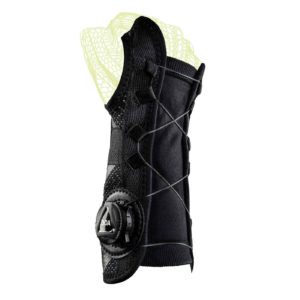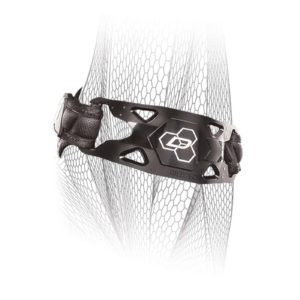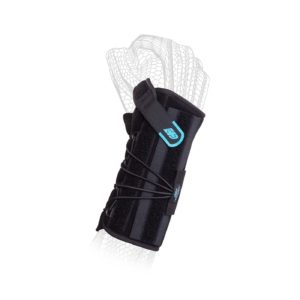Mar 27, 2023 | Gamer News Updates, The Whole Gamer
By Gabrielle Muniz
We all want to be the very best. Here are five ways for you to improve as a gamer.
1. Meditation
Gaming can be pretty stressful. There can also be a lot going on, which adds to the pressure and can make it hard to focus and stay calm. By meditating, you can learn tools that will relax your mind and body. Even yoga can relax both the mind and body to bring out the best responses. With some relaxation techniques, you can make a more informed and rational decision while gaming.
2. Eat Healthy
You may not think it, but gaming can take a toll on the body. Since you’re seated for an extended period of time and holding a controller, you’re more likely to develop arthritis and other body ailments. By eating certain fruits and vegetables every day, you’ll be able to get the nutrients that your joints need to stay strong. Don’t just go for the chips.
3. Play Puzzles
It’s essential to keep your mind sharp as a gamer, especially as we get older. What else keeps the mind sharp? Puzzles. Jigsaw puzzles, crossword puzzles, and even Tetris can improve multiple aspects of your brain, such as your short-term memory. As a result, your reaction time can improve while you’re gaming.
4. Don’t Be Afraid to Watch Playthroughs
Once you think you’re the best, you stop learning. Once you stop learning, you stop having fun. By opening yourself up to finding tips, tricks, online playthroughs, and tutorials, you may discover things you’ve never known about your favorite game. Developers take years to come up with your favorite games, so it could take years for a player to master them.
5. Listen to Music
This works especially well for anxious gamers and…well, me. If you find yourself getting a sensory overload or becoming too anxious about your game, then try muting your television and putting on your favorite song. Music can help your brain to focus, can improve your mood, and can help you relax. Try out different types of music to see what you respond to the best.
No matter what we’re playing, gaming is just like any other sport. You have to keep training to keep your skills. With these tips, you can find out just how good you can be. Try to reach your maximum potential!
Guest Author: Gabrielle Muniz
Mar 13, 2023 | Gamer News Updates, The Whole Gamer
Nintendo is spoiling us with four waves of DLC (downloadable content) for Mario Kart 8: Deluxe. They’ve included new tracks, old tracks, and some classic tracks with new twists! Here are five must-see tracks that will have all Mario Kart fans driving for hours.
1. Maple Treeway (Mario Kart: Wii on Nintendo Wii)
You can get some serious height in this giant forest. Watch out for Wigglers, some sharp turns, and piles of leaves with hidden banana peels! I absolutely love the music to this track. It’s so lively and really embodies the autumn season. There is some great scenery, too, as you drive through falling leaves and elaborate tree houses.
2. Daisy Cruiser (Mario Kart: Double Dash on Nintendo GameCube)
It’s one of the more challenging and exciting levels of this game. This course lets you drive around on Daisy’s large cruise ship in the middle of the ocean. Look out for the pool on the deck, some sliding tables in the dining area, and a surprise trap door that can give you a great shortcut through the engine room.
3. Merry Mountain (Mario Kart Tour on Android and iPhone)
If you love the holiday spirit, then this level is the ultimate playground for you. This is one of the best looking levels in the game, as you race through an ornately decorated Christmas village. There are lights, mountains of presents, and even a toad driving a holiday train in the air! This would go great with a December release for the third wave of DLC: just in time for the holidays!
4. Wario Colosseum (Mario Kart: Double Dash on Nintendo GameCube)
This is another hidden gem of a level. As you race through Wario’s Colosseum, you only get two laps. However, these laps are filled with long, winding turns that can really be hit or miss for even the most experienced gamers. Make every drift count!
As we anxiously await the next wave of DLC, it’s clear that Nintendo has some amazing courses to choose from. They can surprise us with some all-new tracks, but the courses on this list are just too good to forget. Stay ready for anything, as the 3rd wave of DLC will dash up before we know it!
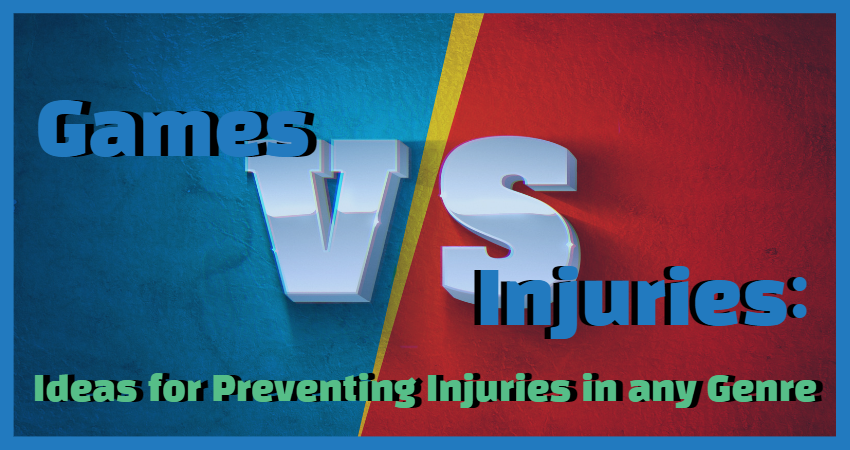
Feb 21, 2023 | Gaming and Your Body, The Whole Gamer
With the esports landscape evolving and increasingly more game developers appealing to the competitive aspect of video games, it feels almost overwhelming to pick a new game to focus on. At the same time, one thing that can be said for certain about the rise in esports is that there’s a danger of gaming-related injuries. With that in mind, we wanted to put together a little cheat sheet of injuries for the different types of competitive games out there.
Whether it be a fast-paced shooter or a methodical card game, many esports have some amount of risk of injury associated with them, so let’s break them down!
Shooters (Battle Royales, FPS, etc.)
Shooters tend to be the most problematic of the genres for injuries. They focus on a lot of fine motor skills and general movement of the arm and wrist. As such, some professionals in these esports, such as Call of Duty’s ZooMaa, have been forced to retire due to wrist and hand injuries. These injuries can be caused by actions such as excessive flicking motions and overuse due to long hours.
We recommend preventing these injuries by wearing equipment such as arm braces and wrist guards which can provide support and relief. We also recommend taking breaks when possible and resting your arms and wrists during gaming sessions.
Strategy Games (TCGs, RTSs, etc.)
Strategy games, while not very physically intensive, do require a lot of focus and attentiveness. Card games like MTG: Arena or Yu-Gi-Oh rely heavily on one’s ability to keep track of what cards you and your opponent have played. They may also require you to read small card text from time to time, which can lead to eye strain if you are trying to climb the ranked ladder or are practicing for long hours. Other strategy games may not require as much attention to fine detail but will require more APM (Actions Per Minute). Games like Starcraft involve additional clicks and button presses, which can definitely wear harder on the joints in your hand.
For most strategy games, we recommend a set of blue light glasses to lessen the amount of strain on your eyes and compression gloves to lower the strain on the joints in your hands and fingers.
Sports Games
While sports games may not dominate esports, the competitive scene is still very much alive and well. These games are played on controllers in the highest-skill division. As such, a lot of injuries that occur from playing sports games tend to be in the wrists, fingers, and thumbs.
Because of this, we recommend wearing compression gloves during practice times and less strenuous gaming sessions.
MOBAs
MOBAs are somewhere in between both Shooters and Strategy games because they rely on mouse movement and quick, precise inputs. Consequently, the number of injuries you may encounter when main gaming a MOBA can vary greatly depending on your playstyle and champion pool. Many professional League of Legends players such as Cloud9’s Hai and Royal Never Give Up’s Uzi have cited various health concerns as the reasons for their retirement as a result of playing LoL in a professional capacity. Whether you play a high APM character or a more methodical one, injuries are bound to occur if you keep grinding out a MOBA.
We believe it is best to play it by ear and seek a remedy for whatever is stifling your play the most. Blue light glasses for your eyes, compression gloves, and wrist guards for your wrist and hands, and compression sleeves for your elbows are all good preventive measures for whatever injury you may feel coming on.
We hope this helps you stay safe in whichever genre you choose to play next!
Guest Author: Kyle Nakasaka
Jan 17, 2023 | Gamer News Updates, The Whole Gamer
With all of the hype that surrounded Super Mario Odyssey back in 2017, it was sure to be the greatest Nintendo platform game yet. As much as Odyssey impressed many, I was left comparing it to an earlier platform game: Super Mario Galaxy. Released ten years prior to Odyssey, Galaxy had quickly become a classic in the series. Here are some reasons why Galaxy is still the definitive Mario game.
Engaging Story and Characters
In Odyssey Bowser has kidnapped Princess Peach, plans to marry her, and wreaks havoc in other kingdoms. It’s a harmless and fun story, but the stakes aren’t as high as with Galaxy. Galaxy’s story involves Bowser stealing stars from the Comet Observatory, the home for Rosalina and the Lumas. As you collect the stars for the Observatory, you learn more about Rosalina and the Lumas through storybook renderings. Throughout, you really want to help such loveable and memorable characters. Also, Bowser is fierce, as he creates a Galaxy Reactor to rule the galaxy in the center of the universe. It’s his most dangerous plan yet.
Enchanting Music
Galaxy was the first Mario game to feature an orchestral sound, giving it a grand and cinematic feel. Odyssey follows suit, but I honestly cannot recall many memorable tunes from it. Fossil Falls comes close, and “Jump Up, Super Star!” is certainly a lively number, but Galaxy‘s score is more captivating. The main theme, the theme for the Comet Observatory, and the Space Junk Galaxy are just a few that stand out. Personally, Koji Kondo, a composer of both games, just couldn’t present the same kind of magic in Odyssey that he did so successfully in Galaxy.
“Luigi time!”
Once you have collected all 121 stars in Galaxy, you get the chance to play through the game once again as Luigi. In Super Luigi Galaxy, you can move faster, jump higher, and have an overall change in game play. In Odyssey, Luigi really gets the short end of the stick, as he hosts an online mini game, Balloon World, where you must find hidden balloons in a certain amount of time. The mini game is just fine, but no Luigi Odyssey? Super Mario Galaxy is a masterpiece in gaming. The puzzles, the music, and the story all work seamlessly to create an incredible experience. However, both Odyssey and Galaxy will go down in gaming history as some of Mario’s greatest adventures yet.
Guest Author: Gabrielle Muniz
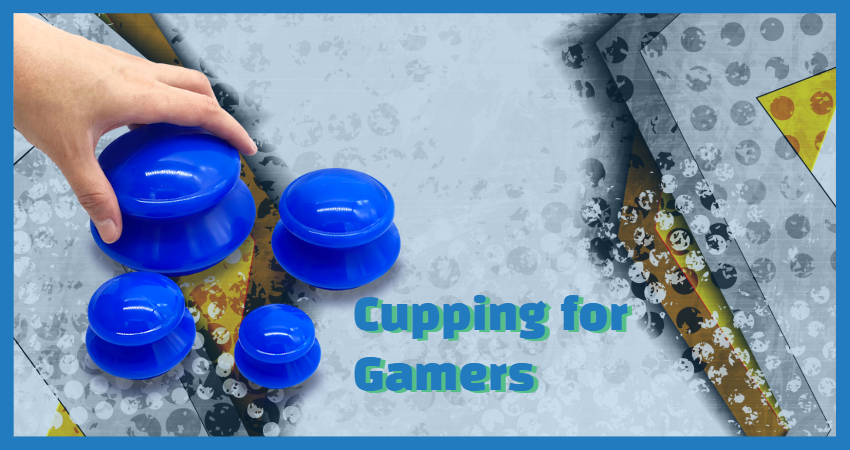
Jan 10, 2023 | Gaming and Your Body, Treatments
Depending on your setup, you have probably felt aches and pains after a long session of gaming. Many gamers, professional or casual, experience significant pain in their wrists, shoulders, and back[1]. This is due to the long periods gamers spend sitting in sometimes uncomfortable positions that strain key muscle groups, nerves, and the spine.
While the best method to help reduce pain is to take regular breaks and limit gaming sessions, this is not always feasible when one is training for competitive play or seriously invested in an engrossing quest line[1]. Painkillers like acetaminophen (Tylenol) are helpful for muscle pains caused by extended gaming, but they adversely affect the body if used in excess[2]. As a result, many gamers look for alternative options to help safely manage gaming-related pains and aches. One such option is cupping.
What is Cupping?
Cupping is a treatment practiced in many cultures since antiquity, wherein a person applies cups to the surface of the skin using suction[3, 4]. Egyptian papyrus texts from 1500 BC describe the technique. Other records show that cupping was commonly used in ancient Greece, China, and Western Europe [4]. The technique flourished particularly during the Islamic Golden Age. Many people in Asia and the Middle East currently use cupping for pain relief and other health problems. The practice has become popular with many high-performing athletes in recent years.
How Does Cupping Work?
During cupping, a person places cups on the skin and applies negative pressure to the tissue and underlying muscle. This sticks the cups to the skin, where they remain for 3 – 5 minutes[4-6]. Pressure is usually applied via mechanical pumping.
What are the Effects of Cupping?
Cupping opens up tiny blood vessels in the area, increasing blood flow[4, 6]. As a result of the increased blood flow, cupping therapy can reduce local pains and muscular tension in the areas it is applied to. In addition, cupping targets myofascial adhesions, “knots” or “trigger points” that limit soft tissue flexibility, negatively impacting muscle control and performance [7]. Myofascial adhesions form through microscopic damage caused by exercise, injury, repetitive strain, and normal wear and tear on the body, resulting in pain and tension.
Does Cupping Therapy Have Risks?
By and large, cupping is safe, but there are some inherent risks with the procedure[8]. Cupping therapy can cause large darkened regions of skin due to broken blood vessels, especially when cups are left on too long. However, proper technique and short treatment durations can largely prevent this risk.
Is Cupping Backed by Science?
There have not been many large randomized controlled trials to examine whether cupping is effective for pain management. However, the current body of research suggests cupping treatment can help provide some degree of pain relief, especially when used in conjunction with other pain management strategies[9]. More research is needed to help determine the best methods of cupping therapy moving forward.
Cupping Therapy for Gamers
Cupping therapy has shown mild-to-moderate benefits for aches and pains, many of which are common in dedicated gamers. If you have pain issues from gaming, cupping may be a helpful addition to your wellness strategies.
References
1. Tholl, C., et al., Musculoskeletal disorders in video gamers – A systematic review. BMC Musculoskelet Disord, 2022. 23(1): p. 678.
2. Gerriets, V., J. Anderson, and T.M. Nappe, Acetaminophen, in StatPearls. 2022: Treasure Island (FL).
3. Mehta, P. and V. Dhapte, Cupping therapy: A prudent remedy for a plethora of medical ailments. J Tradit Complement Med, 2015. 5(3): p. 127-134.
4. Furhad, S. and A.A. Bokhari, Cupping therapy, in StatPearls. 2022: Treasure Island (FL).
5. Bridgett, R., et al., Effects of cupping therapy in amateur and professional athletes: Systematic review of randomized controlled trials. J Altern Complement Med, 2018. 24(3): p. 208-219.
6. Al-Bedah, A.M.N., et al., The medical perspective of cupping therapy: Effects and mechanisms of action. J Tradit Complement Med, 2019. 9(2): p. 90-97.
7. Bordoni, B., K. Sugumar, and Varacallo M., Myofascial Pain, in StatPearls. 2022: Treasure Island (FL).
8. Aboushanab, T.S. and S. AlSanad, Cupping therapy: An overview from a modern medicine perspective. J Acupunct Meridian Stud, 2018. 11(3): p. 83-87.9. Kim, J.I., et al., Cupping for treating pain: a systematic review. Evid Based Complement Alternat Med, 2011. 2011: p. 467014.





